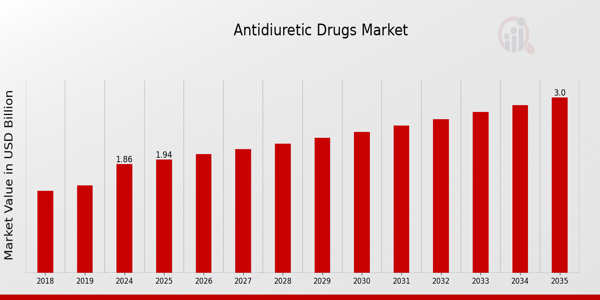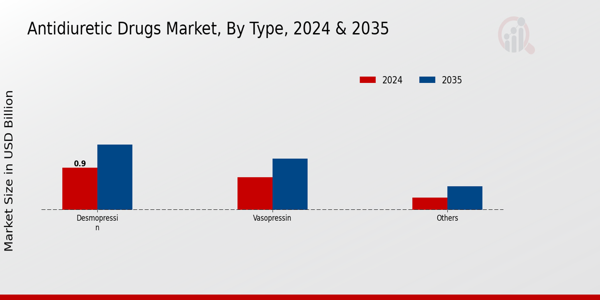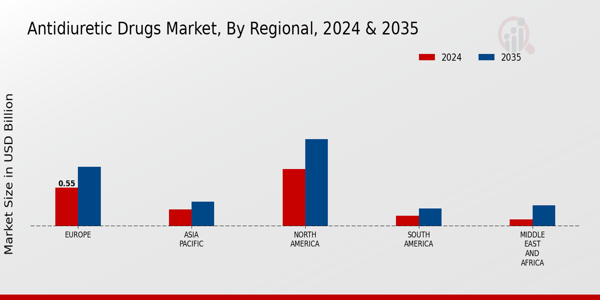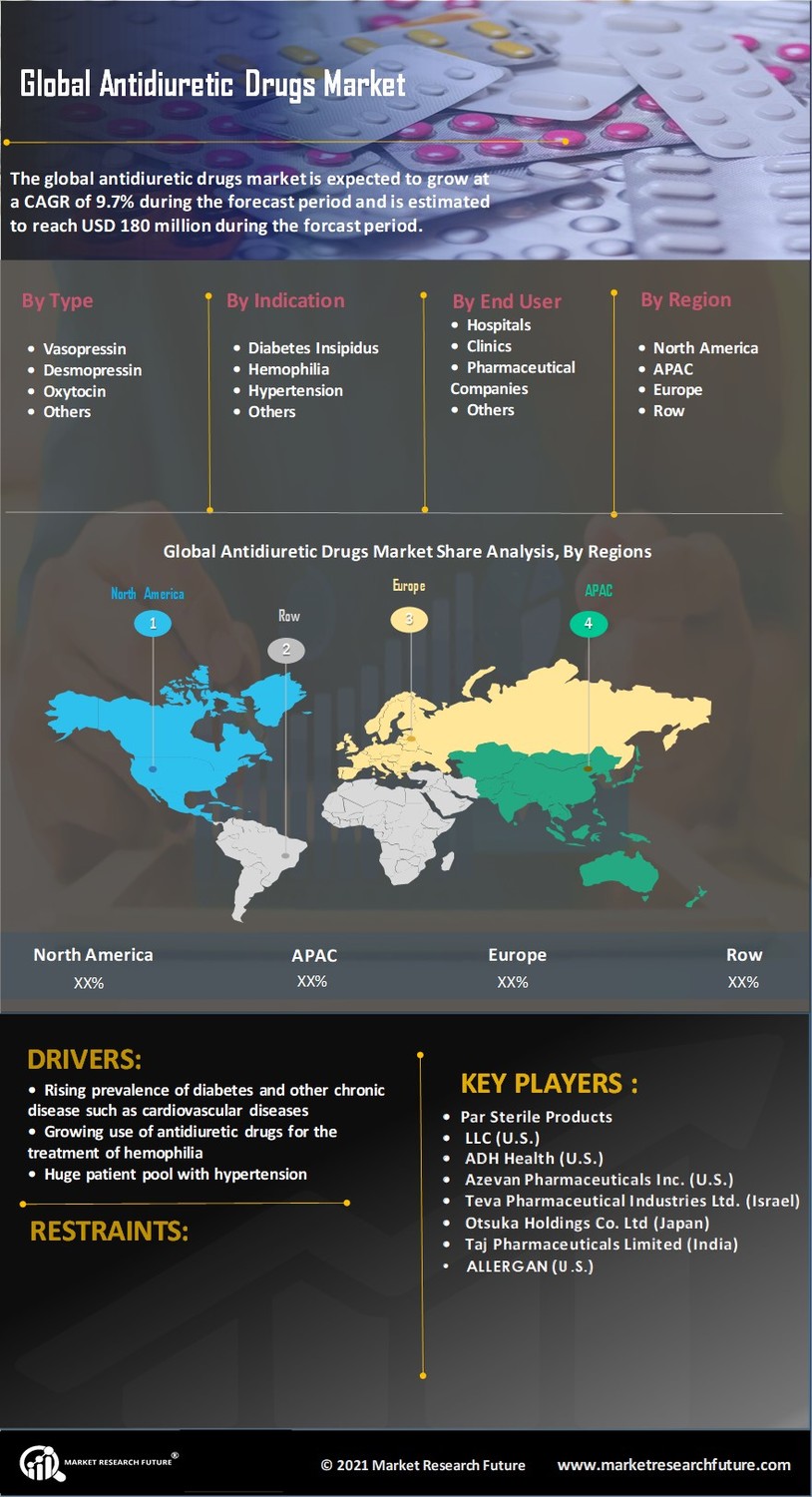Antidiuretic Drugs Market Overview
As per MRFR analysis, the Antidiuretic Drugs Market Size was estimated at 1.78 (USD Billion) in 2023.
The Antidiuretic Drugs Market Industry is expected to grow from 1.86 (USD Billion) in 2024 to 3 (USD Billion) by 2035. The Antidiuretic Drugs Market CAGR (growth rate) is expected to be around 4.44% during the forecast period (2025 - 2035).
Key Antidiuretic Drugs Market Trends Highlighted
The Antidiuretic Drugs Market is currently undergoing significant trends that are being driven by the increasing prevalence of disorders associated with water retention and electrolyte imbalances. The expanding aging population and the increased awareness of medical conditions such as diabetes insipidus are the primary market drivers that are driving demand for these medications.
Additionally, the effectiveness and accessibility of treatment for patients worldwide are being improved by advancements in drug formulations and delivery mechanisms, such as enhanced oral and injectable options, which are enhancing therapeutic outcomes. There are also substantial opportunities to be captured through the development of novel treatment protocols and combination therapies that could address unmet requirements in patient care. The market growth is being driven by the movement toward personalized medicine, which is resulting in the development of antidiuretic therapies that are more specifically tailored to the unique profiles of individual patients.
Recent trends suggest a trend toward the integration of technology in healthcare, including telemedicine and digital therapeutics, which will facilitate the more effective management of antidiuretic drug therapy.
The global increase in research and collaboration between pharmaceutical companies and research institutions is revealing new potential therapies in this field. In addition, regulatory agencies worldwide are emphasizing the acceleration of innovation and the expedited availability of new antidiuretic pharmaceuticals by streamlining the approval process.
In order to thrive in this dynamic global environment, market participants must remain attentive to the changing regulatory landscapes and patient needs.

Antidiuretic Drugs Market Drivers
Increasing Prevalence of Disorders Requiring Antidiuretic Drugs
The Antidiuretic Drugs Market Industry is significantly driven by the rising incidence of conditions such as diabetes insipidus and various forms of kidney disorders, which necessitate the use of antidiuretic medications. According to the Global Health Organization, more than 300 million people worldwide are affected by diabetes-related disorders, with a notable increase in diabetes insipidus cases over the past decade.
It is estimated that about 1 in 25,000 people globally are diagnosed with diabetes insipidus, highlighting the growing patient population that requires antidiuretic drugs.With organizations such as the American Diabetes Association continuously working to raise awareness and improve treatment options, the demand for effective antidiuretic medications is anticipated to rise steadily, bolstered by ongoing developments in drug formulations and personalized medicine. As healthcare systems become more integrated and focused on patient-centered care, the Antidiuretic Drugs Market Industry stands to benefit from the increasing accessibility of these vital medications.
Innovations in Pharmaceutical Research and Development
The Antidiuretic Drugs Market Industry is propelled by advancements in pharmaceutical Research and Development (R&D) aimed at creating more effective and safer antidiuretic agents. A report from the National Institutes of Health estimates that funding for biomedical research has increased by approximately 25% over the last five years. This influx of funds has led to innovative developments in drug formulations, enhancing the efficacy and minimizing adverse effects of existing antidiuretic drugs.Leading pharmaceutical companies, including Pfizer and Novartis, are actively investing in R&D for new therapeutic approaches, which can significantly impact their market standing.
As new antidiuretic drugs enter the market, they facilitate improved treatment options for patients suffering from related disorders, ultimately driving market growth.
Growing Geriatric Population with Health Complications
The Antidiuretic Drugs Market Industry is also driven by the expanding geriatric population, who are more susceptible to health complications requiring antidiuretic therapy. According to the World Population Prospects, individuals aged 60 and above are projected to reach nearly 2.1 billion by 2050, highlighting a demographic shift that necessitates increased healthcare services, including antidiuretic drugs.
Older adults often encounter kidney functionality issues, thereby increasing the prevalence of conditions like hyponatremia that may require antidiuretic treatment.Organizations such as the International Association of Gerontology and Geriatrics are advocating for improved treatment options for the elderly, thus contributing to an upsurge in demand for antidiuretic drugs within this demographic.
Enhanced Awareness and Education about Antidiuretic Measures
The Antidiuretic Drugs Market Industry is experiencing growth due to enhanced awareness and educational initiatives regarding the importance of antidiuretic measures. Various health agencies, including the Centers for Disease Control and Prevention (CDC), are focusing on campaigns aimed at educating healthcare professionals and patients about the implications of conditions requiring antidiuretic drugs.
This increased awareness has been linked to a notable rise in reported cases of diabetes insipidus and related disorders, with estimates suggesting that undiagnosed cases may comprise up to 50% of patients, highlighting the necessity for effective treatment.The proactive approach by healthcare organizations is not only improving diagnostics and patient outcomes but is also driving the demand for antidiuretic therapies, significantly impacting growth in the Antidiuretic Drugs Market.
Antidiuretic Drugs Market Segment Insights
Antidiuretic Drugs Market Type Insights
The Antidiuretic Drugs Market is significantly influenced by its Type segmentation, divided primarily into Desmopressin, Vasopressin, and others, catering to various therapeutic needs and patient conditions globally. In 2024, the market for Desmopressin alone reached a valuation of 0.9 USD Billion, asserting its importance in managing conditions like diabetes insipidus and nocturnal enuresis, which account for a major share of antidiuretic therapies due to the prevalence of these disorders.
The dominance of Desmopressin in the market is underscored by a strong efficacy profile and increasing usage in pediatric populations, which fosters a growth trajectory leading to an expected value of 1.4 USD Billion by 2035.Similarly, Vasopressin was forecasted at 0.7 USD Billion in 2024 and is acknowledged for its crucial role in treating septic shock and certain forms of shock-related hypotension. By 2035, this segment is estimated to rise to 1.1 USD Billion, indicating its significance due to rising incidences of critical illnesses worldwide requiring vasopressor therapy.
The 'others' category, which includes various antidiuretic agents, is anticipated to account for a smaller yet notable share with a valuation of 0.26 USD Billion in 2024 and is expected to reach 0.5 USD Billion by 2035.While this segment is lesser in market size, it remains essential due to the development of novel therapies that address niche medical needs.
Altogether, the Antidiuretic Drugs Market revenue showcases the critical role of these types in addressing fluid balance disorders across various demographics, highlighting the market growth potential driven by increasing patient awareness, ongoing research and development, and an expanding global healthcare infrastructure aimed at improving treatment outcomes in fluid management. The dynamics within these segments reflect broader trends in the healthcare market, where specialization and targeted therapies are becoming increasingly relevant, presenting opportunities for stakeholders to capitalize on advancements and innovations in antidiuretic drug formulations.

Antidiuretic Drugs Market Indication Insights
The Antidiuretic Drugs Market reached a valuation of 1.86 billion USD in 2024, representing significant growth in the market. The indications for these drugs, which include conditions such as Diabetes Insipidus, Bedwetting, Hemophilia, and others, play a vital role in driving the market forward. Diabetes Insipidus, a condition that leads to excessive urination, continues to be a dominant indication as it requires precise management to maintain fluid balance. Bedwetting, particularly in pediatric populations, also captures a substantial share, addressing both physical and psychological aspects of the condition.Additionally, Hemophilia, a genetic disorder that complicates fluid regulation, necessitates effective antidiuretic interventions.
Other indications contribute notably to the market but vary in prevalence. The overall market growth is propelled by rising awareness of these conditions, advancements in drug formulations, and an increasing global patient base demanding effective treatment options. Furthermore, the growing prevalence of hormonal disorders worldwide opens new avenues for market expansion, while challenges such as drug compliance and cost remain significant for stakeholders in the Antidiuretic Drugs Market.
Antidiuretic Drugs Market Administration Route Insights
The Antidiuretic Drugs Market reached a value of 1.86 USD Billion in 2024, reflecting a steady growth trajectory driven by increasing incidences of conditions such as diabetes insipidus and other disorders leading to water imbalance. Within this framework, the Administration Route plays a crucial role, as it encompasses various methods including Oral, Intranasal, and Injection approaches. Oral administration remains highly favored due to its convenience and patient compliance; however, Intranasal delivery is gaining traction for its rapid onset of action and ease of use, especially in acute care settings.
Injection routes are also significant, particularly for patients requiring immediate therapeutic effects. The Antidiuretic Drugs Market statistics highlight how each of these administration methods caters to different patient needs, enhancing treatment efficacy. The growth of this market segment is supported by advancements in drug formulation and delivery systems, which aim to improve patient experience and medication adherence. Opportunities for innovation in the Administration Route segment are further propelled by the rising demand for personalized medicine, paving the way for tailored treatment options that align with individual patient profiles and needs in the Antidiuretic Drugs Market.
Antidiuretic Drugs Market Patient Type Insights
The Antidiuretic Drugs Market, valued at 1.86 USD Billion in 2024, showcases significant growth driven by various patient types including Pediatric, Adult, and Geriatric populations. Each of these segments plays a crucial role in the overall market dynamics. The pediatric segment is notable due to the increasing prevalence of health conditions leading to dehydration and inappropriate antidiuretic hormone secretion among children. The adult demographic, representing a substantial part of the Antidiuretic Drugs Market industry, primarily emphasizes management of chronic conditions that affect fluid balance, such as diabetes insipidus.
Meanwhile, the geriatric segment presents unique challenges related to the aging population, particularly the frequent need for hydration management and the effects of multiple comorbidities.
Technological advances in drug formulations and delivery systems for these specific patient types are expected to enhance treatment efficacy. This market is also shaped by the rising awareness of these conditions, underscoring the importance of tailored therapeutic options. With continuous growth in Antidiuretic Drugs Market statistics, industry stakeholders are focusing on developing innovative therapies that address the distinct needs of each patient group, paving the way for improved health outcomes.
Antidiuretic Drugs Market Regional Insights
The Antidiuretic Drugs Market is projected to show significant growth, with varying contributions from distinct regions. In 2024, North America dominated the market with a valuation of 0.82 USD Billion, growing to 1.25 USD Billion by 2035, owing to advanced healthcare infrastructure and high demand for innovative treatments. Europe follows with a projected valuation of 0.55 USD Billion in 2024 and is anticipated to reach 0.85 USD Billion in 2035, supported by robust pharmaceutical research.
The Asia Pacific region is progressively gaining traction, anticipated to grow from 0.24 USD Billion in 2024 to 0.35 USD Billion by 2035, driven by increasing healthcare expenditure and rising awareness of antidiuretic therapies.South America, while smaller with a projected valuation of 0.15 USD Billion in 2024, is expected to reach 0.25 USD Billion by 2035, reflecting emerging market dynamics. The Middle East and Africa, valued at 0.1 USD Billion in 2024, is forecasted to expand to 0.3 USD Billion, supported by improving healthcare access.
This varied regional landscape highlights the significant opportunities within the Antidiuretic Drugs Market, emphasizing the importance of understanding local market dynamics for effective strategy formulation.

Antidiuretic Drugs Market Key Players and Competitive Insights
The Antidiuretic Drugs Market is characterized by a dynamic competitive landscape, driven by an increasing prevalence of various health conditions that necessitate the use of antidiuretic medications. These drugs play a crucial role in the treatment of disorders related to vasopressin deficiency and fluid imbalance, leading to significant demand in the market. Competitive strategies among key players revolve around innovation in drug formulations, strategic partnerships, and expansion into emerging markets. As the market continues to evolve, companies are also focusing on enhancing patient access to these medications while ensuring adherence to regulatory standards.
Moreover, an emphasis on research and development is prevalent, with firms investing in advanced technologies to improve therapeutic outcomes, thus enhancing their competitive positioning.In the context of the Antidiuretic Drugs Market, Novartis stands out due to its robust presence and commitment to advancing healthcare solutions. The company is recognized for its innovative approach in developing antidiuretic medications tailored to meet the diverse needs of patients. Novartis boasts a strong reputation for maintaining high-quality standards and effectiveness in its pharmaceutical offerings in the antidiuretic segment.
Its established distribution channels and global reach contribute to its competitive edge, allowing for the seamless supply of products across numerous markets. The company’s solid financial performance and enduring focus on research and development strengthen its presence in the industry, enabling it to adapt swiftly to changing market dynamics and consumer demands.Teva Pharmaceutical Industries plays a significant role in the Antidiuretic Drugs Market, leveraging its extensive portfolio of generic and specialty medicines. Teva's strategic focus on affordability and accessibility has positioned it as a preferred choice among healthcare providers across different regions.
The company’s strengths lie in its robust pipeline of antidiuretic products, which are designed to address various medical conditions with efficacy and safety. Teva has made notable efforts to expand its market presence through acquisitions and partnerships, enhancing its capabilities and product offerings. Furthermore, Teva's emphasis on patient-centric initiatives and innovative formulations resonate well within the global landscape, ensuring the company remains competitive in meeting healthcare needs effectively and efficiently. Through these strategic maneuvers, Teva continues to solidify its footing in the Antidiuretic Drugs Market.
Key Companies in the Antidiuretic Drugs Market Include:
- Novartis
- Teva Pharmaceutical Industries
- Mylan
- Boehringer Ingelheim
- Pfizer
- Fresenius Kabi
- Gilead Sciences
- Amgen
- AstraZeneca
- Sanofi
- Eli Lilly
- Otsuka Pharmaceutical
- Roche
- BristolMyers Squibb
- AbbVie
Antidiuretic Drugs Market Industry Developments
Adalvo and its strategic partners introduced a desmopressin formulation (based on Minirin Melt) in April 2024 in numerous European countries, thereby increasing the availability of oral antidiuretic treatment options.
Adalvo expanded its consumer-friendly delivery portfolio for diabetes insipidus management by introducing sublingual desmopressin tablets in France in February 2024.
Merck & Co. introduced a novel antidiuretic therapy in October 2023, which has garnered positive feedback for its efficacy in treating fluid-balance disorders, thereby improving its market position.
Pfizer announced in September 2023 that it intends to enhance the specificity and convenience of next-generation therapies by expanding research and development of novel antidiuretic compounds.
Teva Pharmaceutical Industries expanded its cardiovascular and renal product lines by acquiring an additional portfolio of antidiuretic medications from a competitor in September 2023.
Furthermore, in June 2023, Fresenius Kabi introduced a generic version of vasopressin (Vasostrict) in the United States, thereby expanding the availability of treatment for vasodilatory shock.
Antidiuretic Drugs Market Segmentation Insights
Antidiuretic Drugs Market Type Outlook
- Desmopressin
- Vasopressin
- Others
Antidiuretic Drugs Market Indication Outlook
- Diabetes Insipidus
- Bedwetting
- Hemophilia
- Others
Antidiuretic Drugs Market Administration Route Outlook
- Oral
- Intranasal
- Injection
Antidiuretic Drugs Market Patient Type Outlook
- Pediatric
- Adult
- Geriatric
Antidiuretic Drugs Market Regional Outlook
- North America
- Europe
- South America
- Asia Pacific
- Middle East and Africa
|
Report Attribute/Metric
|
Details
|
|
Market Size 2023
|
1.78 (USD Billion)
|
|
Market Size 2024
|
1.86 (USD Billion)
|
|
Market Size 2035
|
3.0 (USD Billion)
|
|
Compound Annual Growth Rate (CAGR)
|
4.44% (2025 - 2035)
|
|
Report Coverage
|
Revenue Forecast, Competitive Landscape, Growth Factors, and Trends
|
|
Base Year
|
2024
|
|
Market Forecast Period
|
2025 - 2035
|
|
Historical Data
|
2019 - 2024
|
|
Market Forecast Units
|
USD Billion
|
|
Key Companies Profiled
|
Novartis, Teva Pharmaceutical Industries, Mylan, Boehringer Ingelheim, Pfizer, Fresenius Kabi, Gilead Sciences, Amgen, AstraZeneca, Sanofi, Eli Lilly, Otsuka Pharmaceutical, Roche, BristolMyers Squibb, AbbVie
|
|
Segments Covered
|
Type, Indication, Administration Route, Patient Type, Regional
|
|
Key Market Opportunities
|
Rising prevalence of diabetes insipidus, Growing geriatric population worldwide, Increased R&D in novel formulations, Expansion in emerging markets, Enhanced awareness and diagnosis levels
|
|
Key Market Dynamics
|
Increasing diabetes prevalence, Rising geriatric population, Growing awareness of conditions, Technological advancements in drug delivery, Expanding healthcare expenditure
|
|
Countries Covered
|
North America, Europe, APAC, South America, MEA
|
Antidiuretic Drugs Market Highlights:
Frequently Asked Questions (FAQ):
The Antidiuretic Drugs Market was valued at 1.86 USD Billion in 2024.
By 2035, the market is expected to reach a valuation of 3.0 USD Billion.
The market is projected to grow at a CAGR of 4.44% from 2025 to 2035.
North America is expected to dominate the market, with a valuation of 1.25 USD Billion by 2035.
In 2024, Europe's market value was 0.55 USD Billion and is expected to increase to 0.85 USD Billion by 2035.
Key players include Novartis, Teva Pharmaceutical Industries, Mylan, and Pfizer, among others.
The market value for Desmopressin was 0.9 USD Billion in 2024.
The Vasopressin segment is projected to be valued at 1.1 USD Billion in 2035.
The South American market is expected to grow to 0.25 USD Billion by 2035.
Regulatory challenges and competition from alternative therapies may impact market growth.


















